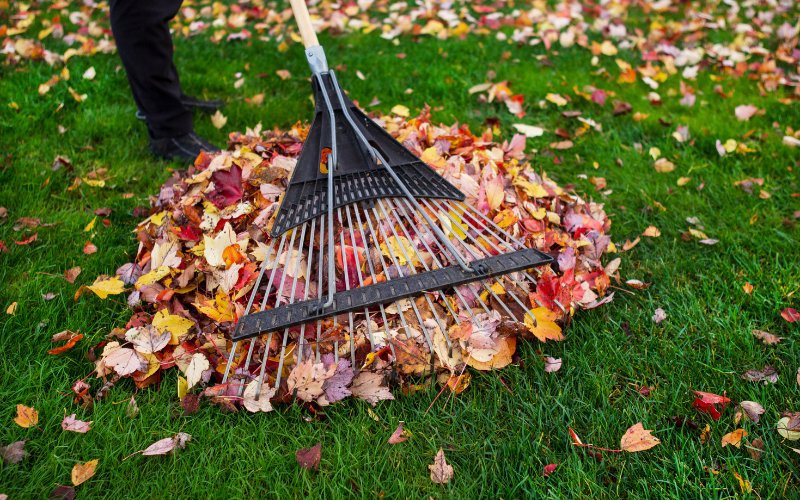My neighbor has a bunch of oak trees, mahogany trees, and countless big bougainvilleas in his yard. While the trees make the street look great, it means that for pretty much most of the year, I have to battle with the leaves blowing into my yard.
Everything looks good for about ten minutes after I cut my lawn, but with the first sign of a breeze, the leaves come again. I’m not happy, to say the least. Well, that was until I worked out how to stop my neighbor’s leaves from blowing into my yard. So, here are a few ideas that could help you if you are going through the same issue in your yard.

Stopping the Neighbor’s Leaves From Blowing into Your Yard? (The Short Answer)
There are really only two ways to stop leaves coming into your yard from your neighbor’s property. The first is to have your neighbor deal with the leaves before they reach your property, and the second is to create a barrier to stop the leaves at your property line, such as a permanent or temporary fence.
How to Stop the Neighbor’s Leaves from Blowing Into Your Yard (3 Strategies to Try)
I reached a point where I just had to do something about my neighbor’s leaves in my yard. I spent a lot of time in my yard trying to get everything as good as possible, and having to allot extra time to deal with my neighbor’s tree leaves dropping in my yard wasn’t working out. So, here’s my plan of attack for how to stop my neighbor’s leaves from blowing in my yard.
Have a Conversation with Your Neighbor
My first thought was to talk to my neighbor and see if they could do anything about picking up their leaves before they reached my yard or if they could come into my yard and blow them back into their yard. Initially, my neighbor agreed they would take care of the leaves, but it didn’t take long before my yard was full of their leaves again.
Now, to give my neighbor some credit, the number of leaves getting into my yard definitely reduced, but a significant amount of leaves were still crossing over between the times my neighbor worked in his yard. The amount of time I would spend cleaning up was much less, but it definitely wasn’t a perfect solution.
So, depending on how you get on with your neighbor, you could try having the same conversation. But I’m guessing I’m one of the lucky ones with an understanding neighbor. You might need a different approach. Let’s take a look at what I did next.
Erect a Temporary Barrier
My next step was to install a temporary barrier to see if I could stop the leaves from actually getting into my yard. I was looking for something I could install and remove easily, which wasn’t going to break the bank.
So, how many temporary barrier options do you want? There are tons to choose from—fabric sheeting, chicken wire, nylon netting, and leaf netting that looks like a hedge. So, after a quick trip down to Home Depot, Lowe’s, Tractor Supplies, and the local farm supplier, I had a ton of options to pick from.
I decided to go for a chicken wire fence because it only cost about $0.75 per foot for the wire, and it seemed like a durable material, which it certainly was. Here are the steps I followed to install a 50-foot temporary fence to keep leaves out of my yard.
Steps to Install a Temporary Leaf Blocker for Your Yard
The first step in installing a temporary leaf blocker is to work out how long you’ll need the fence, how much material you’ll need, and what tools you’ll need on hand. Here is everything I used to complete my 50-foot leaf barrier for my yard.
Tools & Materials to Install a Temporary Leaf Blocker
- Chicken Wire – 50ft
- Wooden Stakes – 11 (1”x2’’x36’’)
- Staple Gun – Galvanised Staples
- Mallet
- Work Gloves
- Tape Measure
- Marking Out Line
Step 1. Marking Out the Fence
Once you have all your tools and material, it’s time to mark out where the temporary fence is going to go. I know where my property line is, so this was straightforward, but I still grabbed my neighbor to look at where I was planning to put the fence. I didn’t want to find myself on the next episode of Neighbors from Hell if my neighbor blew a gasket because I crossed into his yard.
So, once you know where your fence is going, drive in two of your wooden stakes at both ends of the new fence line using your mallet. Then take your marking out line, or a long string/cord, and tie it between the two wooden stakes so that the line is tight to give you a straight reference to install your other stakes.
Step 2. Installing the Wooden Stakes
Now that you have both end wood stakes and your reference line set up, it’s time to install the rest of the wooden stakes. My fence was 50 feet long, meaning I needed one stake every 5 feet, totaling eleven wooden stakes. In short, 50 divided by 5 equals 10, plus the first stake at the start gives me 11. So, Grab your next stake, measure 5 feet along the reference line, and bang in the stake. Then continue down the line every 5 feet, installing the rest of the wooden stakes.
Step 3. Attaching the Wire to the Wooden Stakes
Now it’s time for the chicken wire. Unravel the first few feet of the wire roll and line it up with the first stake. Then, staple the wire to the first stake. Make sure that the wire touches the ground at the bottom so no leaves can get under your fence.
Once you have the wire attached to the first stake, you just need to repeat the process all the way to the end of your fence. When I installed my temporary fence, I had a buddy give me a hand. Keeping the wire taught while stapling at the same time can be challenging.
Install a Permanent Fence
My permanent leaf blocker worked great for a few years, but then came the time when I wanted something permanent. Looking at the leaves piling up against the wire and the fact that I couldn’t weed-whack the grass under the fence started to become a bit frustrating. So, it was time to look at permanent fence options.
Again how many different options would you like? Wooden, plastic, metal chain link, solid panels, hit-and-miss panels, picket fencing, and the list goes on. I went for a low-level wooden picket and incorporated the chicken wire from my old fence. I was just looking to stop the leaves, and privacy wasn’t an issue.
Here’s everything I used and the steps I followed to install my new permanent fence.
Steps to Install a Permanent Leaf Blocker for Your Yard
Before digging holes in the yard, you’ll have to find out what type of fence you are allowed to have and if you need permission. Where I live, I have to get approval from my HOA and city. So, the HOA gave me a list of products and styles I could use, and the city gave me a permit.
The permit was to ensure the fence was installed correctly and was on my property. Once you have all the paperwork, you can then move on to gathering your tools and materials. Here’s what I used for my picket fence.
Tools & Materials to Install a Permanent Leaf Blocker
- 4×4 inch by 4-foot Treated Landscape Posts x11
- 5-foot x 3-foot Premade Picket Fencing x10
- Post Cement Bags x11
- Wooden Marking Stakes x2
- Marking Out Line
- Tape Measure
- Galvanized Wood Screws
- Electric Screwdriver
- Wood Drill Bits
- Post Hole Spade
- Garden Hose
- Post Level
Step 1. Mark Out the Fence
Marking out the fence is done the same way I mentioned before with my temporary leaf blocker method. Stake both ends of the fence line and join them with a marking-out line. The only difference this time is to make the line longer than your fence if you can so that the stake doesn’t get in the way of your posts.
Step 2. Dig the Post Holes
To dig my holes, I used a post-hole spade. These tools help you dig holes nice and deep without having to dig a wide hole. They are definitely a good investment if you don’t have one. For my 3-foot tall fence, my city stated I needed to use a 4-foot post and one foot of concrete in the ground. So I made sure to dig the holes 18 inches deep, so there was room for concrete underneath the post.
Once you have your first hole dug, you’ll need to measure the next post. I placed my posts 5 feet apart from the center of each post. Now, if you want the fence to sit flush on the first and last posts, you’ll need to deduct 2 inches for your measurement because the first and last posts are attached flush and not centered.
Step 3. Install the Posts
Now that you have dug all the holes, it’s time to install the posts. So, take your first post and drop it into the first hole. Then take your post cement and pour it into the hole with the post. Now, I used a quick setting post cement that doesn’t need to be mixed with water first which is definitely the easiest option.
So, fill the hole with post cement and water it with your garden hose. Then, take your post level and tape measure and make sure the post is at the right height and leveled both side to side and back to front. It would help if you have a few minutes before the post cement starts to cure so you have plenty of time to adjust your posts.
Once you have the first one done, you can repeat the process for the rest of the posts. Finally, even though the cement I used stated it would cure fully within a few hours, I let the posts sit overnight before I moved on to the next step.
Step 4. Attach the Fence Panels
To attach the fence panel, all you need to do is screw them to the posts so that they are level and all at the same height. My panels didn’t come pre-drilled, so I used my electric drill with a wood drill bit to drill holes where I wanted to screw the panels to the post. Using this method saved me from splitting any of the wood. I’m pretty sure Home Depot wouldn’t take them back if I messed them up.
Step 5. Have the Fence Inspected
The final stage of my installation was to have the city come out and inspect the fence. This felt like I was back at school having my science project graded. Thankfully, I got an A+.
Can I Throw My Neighbor’s Leaves Back?
If you’re wondering, can I throw my neighbor’s leaves back into their yard? To be honest, this was the first thing I asked myself way before I even considered a leaf-blocking solution. Unfortunately, the answer is no.
You’ll be breaking a bunch of laws, from trespassing to littering, if you decide to grab your leaf blower and return their leaves. Also, trimming off tree branches that overhang your property from your neighbor’s yard isn’t allowed in most places because it falls under criminal damage. Instead, I recommend talking to your neighbor and installing some type of fence.


Leave a Reply